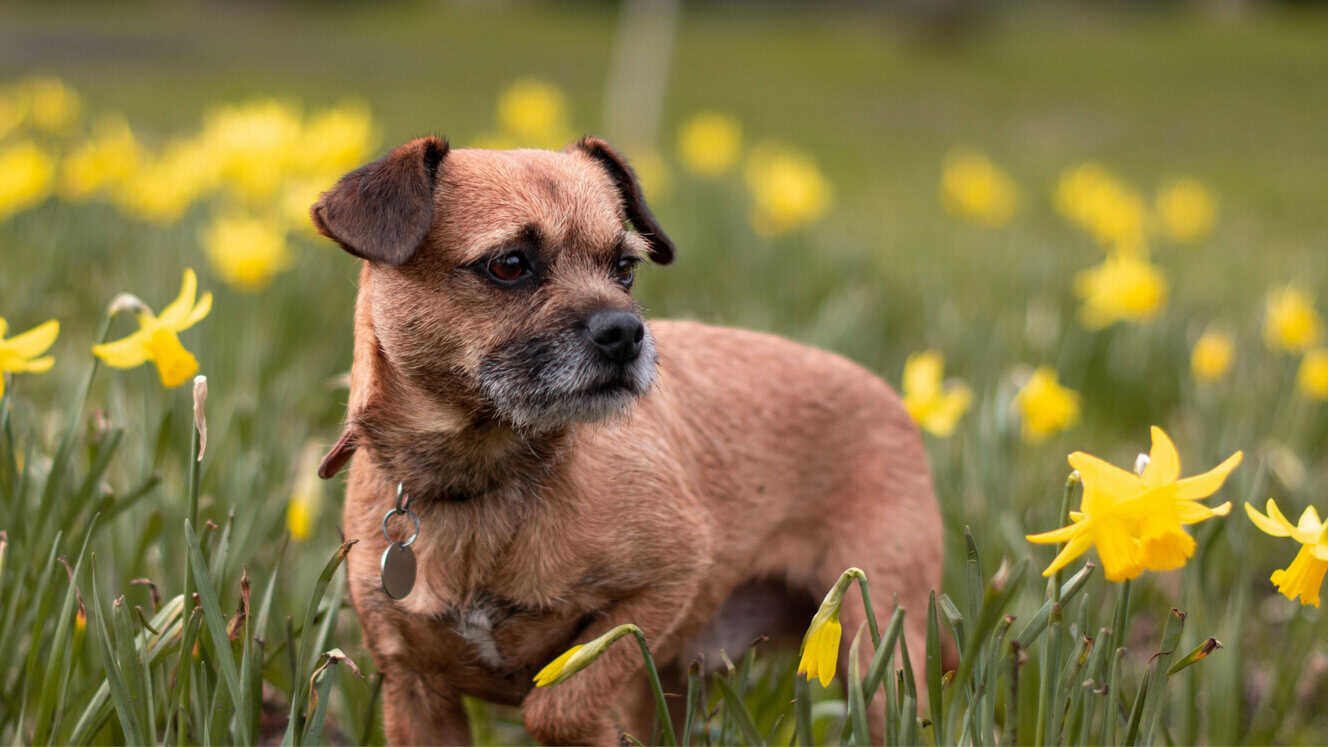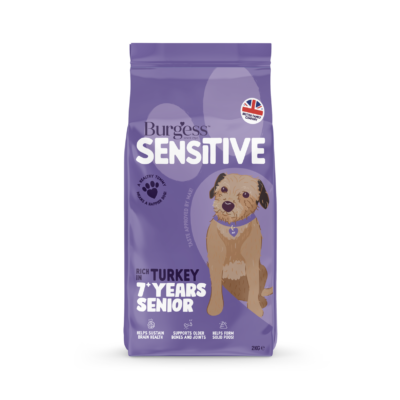
Border Terriers have a very distinctive look. Their head – with its broad skull and short muzzle – resembles that of an otter, and their wiry, all-weather coat and determined dark brown eyes reveal a dog who’s always ready for the next adventure.
“Admirers of the upbeat and agile Border Terrier cherish their breed's reputation as a tough, no-frills working Terrier,” says the American Kennel Club. “These plucky, happy, and affectionate dogs are popular pets in town and country.”
“Despite their small size, Border Terriers are energetic dogs with big personalities to match,” adds veterinary charity PDSA. “Originally bred to work alongside horses and hounds, the Border Terrier tends to get on with people and animals alike. They tend to be fun but feisty, and love to chase!” notes insurer Petplan.
From working dog to wonderful companion
These compact, courageous Terriers originally assisted farmers in protecting sheep in the rugged hill terrain of the borders of Northumberland and Scotland, which gave the breed its name around 1880. While small enough to go down holes to flush out prey, their legs – longer than those of most small Terriers – enabled them to keep up with hunt horses. The breed was officially recognised by the Kennel Club in 1920.
If a small, busy, fun-loving Terrier appeals to you, the breed experts at rescue charity Border Terrier Rescue have some sage advice: “It must be remembered that Border Terriers have been bred for many years as a WORKING dog, who will run with hounds, go to ground when necessary, attack and defend itself as required and is a TERRIER, not a lapdog! This means that Borders need appropriate exercise, not just a potter down the road and back twice a day. They need mental stimulation, a structured routine, making sure they don’t over push boundaries. And they have to be watched with other, strange, dogs as they can be defensive. Having said that, owning a Border Terrier is very rewarding; they are wonderful companions, will walk all day without tiring and curl up quietly by the fire in the evening.”
What’s the best food for a Border Terrier puppy? >>
While generally a healthy breed, there are some health concerns to consider. Border Terriers can be more susceptible than other breeds to epilepsy and diabetes, which can be managed with medication and regulated feeding routines. They can also suffer from skin disorders.
Petplan advises: “Like many other breeds, Border Terriers can suffer from allergies that lead to dermatitis (skin inflammation). Allergies can be caused by many different items, including things that are inhaled (such as pollen or dust mites), items that are eaten (for example, wheat), items that the dog comes into contact with (for example, washing powders), or bites from parasites such as fleas.”
What’s the best food for Border Terriers? >>
Dogs Trust advises: “Whatever the breed, all dogs need basic preventative health care like vaccinations and flea and worming treatments. You’ll also need insurance to help cover the cost of vet bills.”
Understanding what makes your Border Terrier tick will help you give them everything they need to love life! Read on to discover more about:
- BORDER TERRIER PERSONALITY PROFILE
- IS MY HOME SUITABLE FOR A BORDER TERRIER?
- HOW MUCH EXERCISE DOES A BORDER TERRIER NEED?
- WHAT SHOULD I FEED A BORDER TERRIER?
- HOW MUCH GROOMING DOES A BORDER TERRIER NEED?
- WHAT’S THE BEST WAY TO TRAIN A BORDER TERRIER?
- GETTING A BORDER TERRIER
BORDER TERRIER PERSONALITY PROFILE
“Border Terriers are energetic and excitable little dogs who are very quick and agile,” says PDSA. “They are clever dogs, so a Border Terrier can get bored quite easily. They’re skilled escape artists so it’s best to keep them occupied as much as possible.”
“Sociable, playful, affectionate and cheeky, Border Terriers are great family dogs for active households with lots going on,” adds Petplan. “Known for their plucky independence, they tend to be self-assured and unlikely to back down if challenged, so extra care should be taken when introducing them to other animals. Like all Terriers, this breed has a loud bark and can be very vocal.”
“This breed likes to make themselves heard!” agrees rehoming charity Woodgreen. “So, if you’re looking for a quiet dog, a Border Terrier won’t be for you. Not everyone has the time to be a Border Terrier owner! They need to embrace these little dogs’ quirks and fulfil their physical and emotional needs to keep them happy and healthy.”
Crate training a Border Terrier puppy – make it their special place >>
Whatever the breed, every dog is unique
While each breed has certain identifiable traits, it’s important to remember that every dog is unique.
Dogs Trust says: “Just like you, every dog is an individual with their own unique personality and prior experiences. So, every Border Terrier temperament is different. As dogs grow from puppies, they learn all about the world. They develop their own likes and dislikes and learn to respond to situations in different ways. For example, some dogs might like meeting other dogs, and some may not. Some might like new experiences and others may need to go slowly.”
Want just YOUR dog to come when you call them? Choose their name wisely! >>
IS MY HOME SUITABLE FOR A BORDER TERRIER?
To create a perfect canine/human partnership, it’s vital to think about what kind of energy and temperament you’d like your four-pawed friend to have so you’re a good match for each other – and that you can provide a suitable environment.
The Kennel Club recommends that Border Terriers are happy in a small house with a small to medium garden in either a town or country location.
“Border Terriers are a very adaptable breed and are happy in a variety of situations which is why they are such popular pets,” says PDSA. “They fit in well with most families as long as you have plenty of time to spend with them. They love to play and interact with their owners at any given opportunity so can be great companions.”
Petplan adds: “Border Terriers are excitable well into their teens, so are best suited to owners who can give them lots of exercise and attention.”
Border Terriers need people around most of the time
Because they love to hang out with their human family, Borders need someone who’s home most of the time.
“Border Terriers are known for developing separation anxiety if they are left alone because they form such strong bonds with their owners,” notes PDSA. “It’s better if there is someone with your dog all day and they are not left on their own. A worried and lonely Border Terrier can be very destructive around the house.”
Woodgreen adds: “They can cope with a few hours home alone if the idea is introduced properly and their needs are met. But they won’t thrive if you regularly leave them for a full working day. An active retired or semi-retired person/couple would be ideal. Someone who works part-time or from home could also be a good fit.”
Border Terriers love to dig!
Be aware that if you have a Border Terrier, as with all Terrier breeds (Terrier comes from the Latin terra, meaning 'earth' so the clue is in the name), your garden (which must be completely secure) could take a battering.
Woodgreen advises: “Like other Terriers, they enjoy a good dig. If you love your nice, neat lawn and pretty borders, you’ll need to provide a dig pit. Otherwise, your garden will quickly look like the crater-filled surface of the moon!”
“If you’re thinking of getting a Border Terrier, it is ideal to have a secure garden they can play and have free-time in,” adds PDSA. “Like most Terriers, they tend to chew anything and everything so make sure you have plenty of dog friendly toys to keep them occupied. They are also very good at digging, so it’s worth making sure the garden is fully secure and that they can’t slip under any fences. They’re not the best pets if you like a tidy garden.”
Border Terriers and other pets
Borders may get along with other dogs and even cats, but they are definitely not suited to sharing their home with small furries.
PDSA advises: “As long as your Border Terrier is well-socialised with other dogs from a young age, they should get along well with them. Some owners say that they are a more social breed so you may find they enjoy the company of other dogs.”
“Whilst they’re generally tolerant of other dogs, they can still be bossy and feisty with them! They can live with other dogs, but opposite-sex mixes are best,” notes Woodgreen.
“If your Border Terrier has grown up with a cat, they should get along, but you will need to supervise them when they are together,” says PDSA. “We wouldn’t recommend keeping a Border Terrier with other, smaller pets such as rabbits, guinea pigs and rats as they have such a high prey drive, they might see them as something to chase rather than part of the family!”
Which breed of dog is the right fit for you and the place that you live? >>
Border Terriers and children
“Border Terriers are not known for being aggressive dogs and given the right socialisation will love spending time with children of all ages,” advises PDSA. “This said, don’t forget that Border Terriers are energetic and can sometimes get a little over excited, so make sure to calm playtime down if things are getting too boisterous. Always supervise your Border Terrier with children and vulnerable adults to avoid any accidents.”
Woodgreen adds that Borders: “would suit a home with slightly older children as they can be quite mouthy and too busy for young children.”
“Every dog has their own unique personality that has been shaped by their own experiences of the world,” advises Dogs Trust. “They’ll have their own likes and dislikes and will respond to situations in different ways. However, there are some universal ways to behave safely around them and treat them with respect.”
The family dog – making it work for pets and children >>
HOW MUCH EXERCISE DOES A BORDER TERRIER NEED?
If you enjoy hearty hikes and relish time spent outdoors whatever the weather, then a Border Terrier could be your ideal canine companion.
“Border Terriers are typically high-energy dogs who need lots of exercise to keep them physically and mentally healthy,” says Dogs Trust. “They'll need daily walks, plus plenty of time and opportunity to explore, burn energy, and play. If you love spending active time outdoors, this breed could be a great match for you.”
“Border Terriers have bags of energy and need plenty of exercise every day to stay happy and healthy,” adds PDSA. “They’ll be more than happy to join you on long walks in new places (just remember to keep a tight grip on their lead – one whiff of something to chase and they’ll be off). Your Border Terrier will need a minimum of an hour exercise every day. This should be split into a couple of walks with some off-lead time in a secure area. On top of this, your Border Terrier will also need lots of playtime, training sessions and free time.”
“Don’t let their size fool you!” urges Woodgreen. “Border Terriers are an agile, hardy breed with tonnes of stamina – they’ll go for miles. Border Terriers are also mini hunters and will need help channelling their instincts into things other than finding real prey. Try activities that involve seeking and finding, playing with squeaky toys, and a good old game of tug of war.”
How much exercise do different dog breeds need? >>
WHAT SHOULD I FEED A BORDER TERRIER?
To keep your Border Terrier healthy and happy, choosing a balanced diet that suits them and meets all their nutritional needs is essential.
Burgess in-house vet, Dr Suzanne Moyes MVB MRCVS, who oversees recipe development and product production, advises: “When choosing food for Border Terriers, it’s essential to bear in mind that the optimum diet for your dog is one that supplies the correct number of calories and balance of nutrients for their life stage and lifestyle. This means calculating the nutrient content and dietary components such as protein, fat, carbohydrate and vitamins and minerals required. All Burgess Dog Food is a complete food. This means, whatever variety you choose for your Border Terrier, it will contain all the nutrients they need in the correct balance.”
The benefits of feeding a diet specially developed for dogs with sensitivities
And, as Border Terriers can be prone to allergies, choosing a food that’s specially designed for dogs with sensitivities could be beneficial.
Dr Moyes adds: “Dogs with a delicate digestion or who suffer from allergies need sensitive dog food that’s made without many ingredients known to cause upset tummies and skin issues. These ingredients can include beef, eggs, dairy, wheat, maize, and soya. For many canines with digestive issues or allergies, switching to a sensitive or hypoallergenic variety, depending on what your vet recommends, can make a world of difference to them.”
The benefits of life stage food
Your Border Terrier will also benefit from feeding a variety of food that’s designed to meet their nutritional requirements throughout their life. Puppies need extra energy and other nutrients to support rapid growth. For adult dogs, providing a nutritionally balanced, complete diet will help keep them in tip top condition during the prime of their life. Many older dogs develop specific conditions, such as arthritis – some of which can be eased by feeding a diet designed just for them.
“Your Border Terrier’s diet will vary depending on their age,” recommends PDSA. “You’ll need to feed them a complete, balanced dog food to keep them slim and healthy. Your vet will be able to tell you how much your Border Terrier should be eating. You should feed them a good quality, commercially available, complete dog food. We usually recommend splitting their daily allowance into two meals. If you give your dog the occasional treat or use treats for training, remember to take this into account and reduce their daily allowance. Treats shouldn’t make up more than 10% of their daily calorie intake as this can unbalance their diet.”
Try to feed your dog at the same time every day, measuring out precise portion sizes to get them into a routine. Recommended feeding amounts can be found on dog food packaging, but always ask your vet if you’re not sure. Giving your dog a little more than they need means they could become overweight. If you don’t feed enough, your dog will not be getting all the nutrients they need and will become underweight. Remember to leave at a gap after eating and before exercising.
Woodgreen adds: “These dogs are big foodies, which means you may need to keep an eye on their weight and avoid obesity. Regular physical and mental exercise along with a quality diet will keep your Border Terrier on the right, healthy path.”
Human food that you should never give to dogs >>
HOW MUCH GROOMING DOES A BORDER TERRIER NEED?
With their thick, hardy coats, which come in red, wheaten, grizzle and tan, or blue and tan, Borders have some essential grooming requirements.
Their double coat sheds all year round and requires regular grooming, and they also benefit from professional hand-stripping. Due to their love of exploring outdoors, baths may also be required.
PDSA advises: “Like any dog, your Border Terrier is likely to shed throughout the year. They have short, coarse wiry coats and so a brush a couple of times a week should help keep on top of dead hairs, but they may require professional grooming in spring and autumn to keep them looking smart.”
“Clipping Border Terriers is generally not recommended because this will cause the coat to lose its colour and texture,” suggests Petplan. “Instead, their coats tend to be hand-stripped, a process which is best carried out by professional groomers.”
“As they love to dig and go out on adventures, you might find your Border Terrier is muddy and needs a bath from time to time,” adds PDSA. “Remember to use a dog-safe shampoo and ask your vet for advice if you are unsure.”
Dogs Trust says: “To help your dog feel comfortable with handling and grooming, introduce it in a positive way, one step at a time. Teaching your dog to feel relaxed and confident will make grooming more enjoyable for everyone.”
Regular teeth cleaning is also important to help to prevent plaque and tartar from building up and keep gums healthy.
WHAT’S THE BEST WAY TO TRAIN A BORDER TERRIER?
When it comes to training any dog, it’s all about positive learning, and, with Border Terriers, you’ll have an intelligent but rather wilful pupil!
While a very adaptable breed, training and socialisation from a young age with different people, dogs and experiences is essential to help your Border Terrier become a confident dog, happy to go out and about.
Petplan advises: “Borders are quick learners and easy to train, provided training starts at a young age as their intelligence can also make them stubborn. Spend extra time on recall training as their independent and driven nature means they’re apt to wander off. It’s impossible to override Border Terriers’ high prey drive completely, but early socialisation is essential to avoid unwanted behaviour such as chasing and aggression.”
“In the right hands, Border Terriers can be easy to train as they are such quick learners and eager to please their owners,” adds PDSA “It’s important to use positive, reward-based training as Border Terriers are sensitive and don’t respond well to other training methods. Some Border Terriers are known to be independent when it comes to their training so a firm, but fair attitude is a must. If you’re a first-time owner, you may want to consider taking your dog to training classes.”
“Border Terriers are incredibly smart. They’re motivated by both food and toys, which makes training easier,” notes Woodgreen. “Socialisation and habituation (getting them used to people, animals, and the world around them) are essential for helping a Border Terrier be a good member of the canine community. Their instinct to chase prey will mean that recall training will be a long-term task. As they’re small and friendly, Border Terriers are prone to jumping up. Teaching them to greet people with all four paws firmly on the floor is best. As with most breeds, adolescence can be challenging! So, keep up your training well into adulthood.”
Dogs Trust suggests: “Find out what your dog loves so you can use this to reward them after a success. Whether it’s small food treats, toys or lots of praise, training with rewards is the best way for your dog to learn. As dogs are clever animals, they need suitable mental and physical exercise so that they don't get bored. Learning useful life skills such as recall, loose lead walking and settling are just as important. This ensures that you and your dog can spend enjoyable time together, both at home and out and about.”
Border Terriers enjoy games and challenges so it’s a good idea to incorporate these into your training sessions. Petplan says: “If you feed dry kibble try spreading their meals between hiding places across the garden and let them hunt out their dinner. Border Terriers love to chase so ball games are a great way to make recall training fun.”
Woodgreen adds: “Border Terriers love to play, especially seeking and finding squeaky toys. That squeak won’t last long, though, so be prepared to buy regular replacements. If you don’t think you can find time for daily play sessions, this may not be the breed for you.”
For expert advice and practical training guidance, visit Dogs Trust Dog School >>
GETTING A BORDER TERRIER
“Do plenty of research before getting a Border Terrier,” advises PDSA. “These fun loving and active little dogs need plenty of attention and exercise to make sure they don’t get bored. Despite their small size, they have big personalities and in return for your care and commitment you’ll get a loving and entertaining dog in return!”
“Remember to think about the kind of dog you want,” says Petplan. “It’s important to assess the temperament of the parents (Lucy’s Law dictates that potential owners must be able to see puppies with their mum) and what breeding lines they are from. For example, a puppy bred from showing stock might be calmer and easier to manage than one descended from working dogs.”
PDSA adds: “If you buy from a breeder, make sure your puppy will be well socialised and have all necessary screening tests, health checks and vaccinations. It’s really important that Border Terrier puppies from a breeder get the right early socialisation, so always ask the breeder about how they go about this. We recommend looking for a Kennel Club Assured Breeder as they meet higher standards.”
The comprehensive puppy checklist >>
Alternatively, there are a number of rescue organisations around the country, including Dogs Trust, Woodgreen and Battersea, along with breed-specific rescues such as Border Terrier Rescue, Terrier Rescue and North East Terrier Rescue who would love to hear from you.
Staff will seek to match you with the right dog for your home and lifestyle and provide you with support and useful information about the breed. By choosing a rescue Border Terrier you’ll be giving one of these loyal, loving dogs a second chance at a happy and fulfilling life.
The best breed of dog is rescue >>
Need more advice?
If you’re at all unsure about the best way of feeding your dog or have any concerns about specific nutritional requirements, ask your local veterinary practice for advice. You can also call our expert team, available 9am-5pm, Monday to Friday, on +44 (0)1405 862241 who’ll be happy to help. Alternatively, use our online contact form to get in touch.
CARE MORE Find lots of useful advice on caring for your dog from Burgess, the pet experts >>
SOMETHING TASTY FOR EVERY DOG
Every dog deserves a first-class dinner from puppy to adult and senior. Burgess Pet Care is a British, family-owned company and all our dog foods are made at our own factory in the heart of Yorkshire, using only ingredients that meet our stringent specifications – locally sourced wherever possible to support British farmers
We’ve also developed foods to meet the specific nutritional needs of sporting and working dogs, Greyhounds and Lurchers and dogs with sensitivities.
All Burgess dog food is a complete food. This means, whatever variety you choose for your dog, it will contain all the nutrients they need in the correct balance. By choosing Burgess dog food, you know you can feed your canine companion with complete confidence.
Why choose Burgess Sensitive? Because it’s super-premium nutrition for dogs with sensitive tummies and skin at an affordable price!
Burgess Sensitive is made without ingredients that are known to cause common food allergies that may lead to skin issues. Dogs tend to be allergic to proteins (meat or dairy), most commonly beef. Some dogs will be allergic to other ingredients, such as wheat, eggs and soya. That’s why none of these ingredients are included in Burgess Sensitive recipes, which are available for puppies, adult and senior dogs.
Good to know
- COMPLETE NUTRITION Each of the recipes in the Burgess Sensitive Dog Food range are complete, providing all the nutrients dogs require in the right proportions.
- PORTION CONTROL With dry food, it’s easy to measure out the right sized portion to help your dog maintain a healthy weight.
- HEALTHY AND SAFE The thorough cooking process ensures that any harmful bacteria, such as salmonella, and viruses are destroyed, and the dry food stays fresh inside the pack.
- TEETH FRIENDLY Dry dog food has the added benefit of exercising your dog’s chewing muscles and provides a mild cleaning effect on the teeth.
- MADE IN BRITAIN Crafted at Burgess Pet Care’s own factory in the heart of Yorkshire, Burgess Sensitive Dog Food contains high-quality ingredients that meet stringent specifications, locally sourced wherever possible to support British farmers.
With a whole host of *5 STAR REVIEWS*, our customers have told us:
* “Only food my puppy’s stomach can tolerate at the moment. Love this food!” * “Works well for my puppy and has made a great difference to his digestive system.” * “My doggy loves his food, and it is really good quality. Very happy with the product.” * “My dogs love it and have beautiful shiny coats.” * “My dog seems to like the senior food and it appears to have helped settle his sensitive stomach.” * “My two dogs enjoy the taste of the food. They seem happy and have more energy and bounce. Their coats are glossy and sleek. The end products are easier to pick up. After trying lots of other foods – I'm impressed.” *
Lamb? Turkey? Salmon? Your dog can try them all with our Burgess Sensitive Bundle >>
Is your dog a Burgess dog? Join the Burgess Pet Club for exclusive offers and rewards.
If you found this interesting, you may also like:
PET PERSONALITIES – NATURE V NURTURE When it comes to each of our pets’ personalities and the way they behave with us and other animals they interact with, is this down to nature or nurture? According to animal experts, it’s complicated!
DOG DAYS From puppy to adolescent, through to adult and senior, as your dog goes through different stages, their exercise and nutrition needs change. Find out how to help them stay happy and healthy every day of their lives...
OPEN UP YOUR EYES TO YOUR DOG’S WORLD Understanding how your four-pawed pal interprets the world through their five senses can help you provide them with the best, most enriching life.
FUN AND GAMES IN THE DOG PARK Going to the park is the highlight of many dogs’ day as it’s a chance for canine chums to enjoy a meet and greet and dash about with their best buddies. However, not every dog-to-dog interaction goes to plan and there are definite rules of the game to be followed.
BACK TO DOG SCHOOL Training is an essential part of dog ownership and, whatever age your dog is, training should be part of their regular routine.
BEST BEHAVIOUR – HOW TO TRAIN YOUR DOG TO MAKE A POLITE HELLO Most dogs get really, really excited when they meet a friendly human on their walk – Jumping up, twirling and barking. While this can be cute when they’re a small puppy, it’s not so good when they grow into their paws and jump all over the person in question!
BACK SOON All dogs benefit from learning to manage being on their own for short periods. Otherwise, if you have to leave your dog and they aren’t used to it, it will be very stressful for them.
HOW TO TEACH YOUR DOG THAT IT’S CHILL OUT TIME Are you struggling to find your dog’s off button? While some canines are natural couch potatoes, others need a little encouragement to learn to settle down and be calm. Our expert step-by-step training plan can help.
FOOD ALLERGIES UNDER INVESTIGATION Itchy skin, upset tummy, weight loss? These can all be symptoms caused by diet. If you suspect food could be the issue, where do you start?
COULD YOUR DOG BE ALLERGIC TO YOUR HOUSE? Our four-legged friends can be allergic to all sorts of things, from chemicals in cleaning products to pollen, dust, fleas and even smoke from cooking.
DID YOU KNOW THAT OUR PETS CAN SUFFER FROM HAY FEVER TOO? While the cause of pollen allergy is the same in pets as it is in humans, the signs that your pet is suffering from hay fever can be a little different.
GIVE THE DOG A CHOICE As humans, our lives consist of choices. Yet, how much of a say do our dogs have about what they do, how they do it and when? Could letting them make their own decisions really make them happier?
DOG TRAINING MYTHS BUSTED All sorts of people have opinions on the best ways to train a canine – but it’s essential to only take advice from expert, trusted sources.
DOG BEHAVING BADLY? What’s the thing that your dog does that you find baffling, frustrating or even downright annoying? Barking at people walking past the window, ripping up the post, digging holes in the lawn, eating food out of the bin or running off with your slippers?
ARE YOU READY FOR A DOG? Taking on a dog is a huge decision. It requires money, time and commitment. Here are some of the things you’ll need to consider...
PET INSURANCE EXPLAINED Can you get pet insurance for pre-existing conditions? Can you get pet insurance for older pets? Can you get multi-pet cover? We answer some of the most commonly asked questions to help you make an informed decision about pet insurance.
FAD DIETS – SHOULD DOG OWNERS BE WORRIED? Raw, grain free or home-cooked? The range of options for feeding your dog seems to be ever expanding. But what do animal nutrition experts have to say about it?
Featured products















